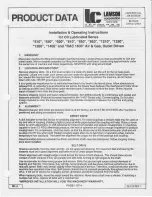
Figure 3-
3
Setting Up
Your Snow
Thrower
WARNING
Never use your hands
to clean snow and
ice from the chute
assembly or auger
housing.
IMPORTANT
Under any circum-
stance do not exceed
manufacturer’s recom-
mended psi. Equal tire
pressure should be
maintained at all times.
Excessive pressure
when seating beads
may cause tire/rim
assembly to burst
with force sufficient to
cause serious injury.
Refer to sidewall of
tire for recommended
pressure.
Clean-Out Tool
The clean-out tool is mounted to the rear of the auger
housing and is designed to clear a clogged chute. Refer
to page 11 for instructions on how to properly use it.
NOTE:
This item is fastened with a cable tie to the rear
of the auger housing at the factory. Cut the cable tie
before operating the snow thrower.
WARNING: Never use your hands to
clean snow and ice from the chute
assembly or auger housing.
Lamp Wiring Harness (If equipped)
The post on the cable tie attaching the lamp wiring
harness to the lower handle should be plugged into the
hole in the lower handle. Pull the slack portion of the
wiring harness through the cable tie to prevent interfer-
ence with the recoil starter handle.
Clean-Out
Tool
Skid Shoes
Position the skid shoes based on surface conditions.
Adjust upward for hard-packed snow. Adjust downward
when operating on gravel or crushed rock surfaces. See
“Making Adjustment” Section.
Tire Pressure (Pneumatic Tires)
The tires are over-inflated for shipping purposes. Check
the tire pressure before operating the snow thrower. Refer
to the tire side wall for tire manufacturer’s recommended
psi and deflate (or inflate) the tires as necessary.
NOTE
: If the tire pressure is not equal in both tires, the
unit may not travel in a straight path and the shave plate
may wear unevenly.
General Recommendations
1. Always observe safety rules when performing
any maintenance.
2. The warranty on this snow thrower does not cover
items that have been subjected to operator abuse
or negligence. To receive full value from warranty,
operator must maintain the snow thrower as
instructed here.
3. Some adjustments will have to be made periodically
to maintain your unit properly.
4. Periodically check all fasteners and make sure these
are tight.
Figure 3-10









































